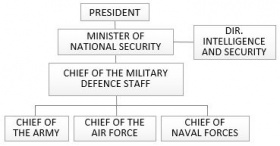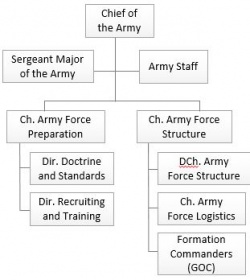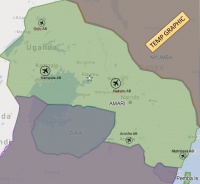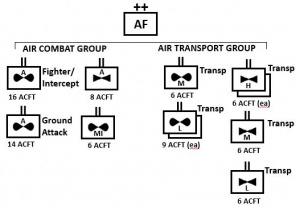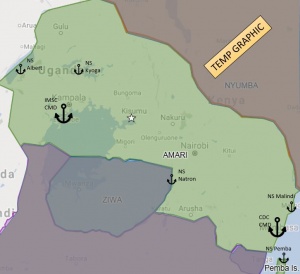Military: Nyumba
Contents
- 1 Nyumba National Command Authority
- 2 National Strategic Goals
- 3 Nyumba National Army (NNA)
- 4 Nyumba Armed Forces Air Service
- 5 Nyumban Naval Forces
The Nyumban Armed Forces (NAF) is the state military of Nyumba and is key to the country’s stability. It has experienced significant challenges from both the various threat actors in Nyumba, and distrust within its ranks and from politicians. Civilian distrust is particularly high, leading to widespread tribalism and the rise of armed militias. Its composition and deployments are driven by political desires to maintain control of key forces and the de facto ceding of territory to tribes or armed groups. The NAF consists of the Nyumban National Army (NNA), the Nyumban Armed Forces Air Corps, and the Nyumban Navy. The Nyumban National Security Service controls a paramilitary group, the Rapid Security Forces (RSF) which is usually deployed in support of border and anti-insurgency operations.
The NAF has inherited a varied structure and culture due to several regime changes and colonial legacy. The lawlessness of the territory and general instability has heightened both political and military leaders’ wariness of the forces. Rather than adequately resourcing its forces, Nyumba has historically accepted peacekeeping force contribution and foreign advisors to help keep its force relatively functional and trained.
The military, despite its ideological purges and the weakening of discipline because of the introduction of ideological affinities in officers’ promotions, remains a traditional army that sees itself as “national” and non-tribal. Successive governments in Nyumba have relied on tribally-recruited militias to augment the national armed forces. The most recent example is the integration of elements of the Tajammu Militias. Defense spending and percentage of GDP included over the last five years averaged 5.2% of GDP.
| Amari | Kujenga | Ziwa |
|---|---|---|
|
|
|
Nyumba National Command Authority
The National Command Authority (NCA) construct of Nyumba exercises overall control of the application of all instruments of national power to plan and carry out the national security strategy. The President exercises significant control over the military and intelligence organizations. The three primary security-related department heads are the Chief of State Security, Chief of Internal Security, and the Director of the National Security Service. While their official hierarchy is specified, there are numerous informal power relationships that may impact military conduct and the execution of national power. The department chiefs are appointed directly by the president and are almost exclusively affiliated and aligned with his tribe.
National Strategic Goals
The President determines the direction and scope of Nyumba’s strategic mission. Nyumba’s overall goals include regime preservation and dominance, defense of its natural resources, border integrity and control, and maintaining internal security against rebels. Any of the department chiefs may publish supplements related to the scope of their responsibilities. Nyumba has publicly stated that it retains the authority to conduct strikes, both within its territory and across the border to address what it perceives as threats to the nation.
Examples of strategic goals supplements include:
- Security and preservation of the regime
- Seizing and establishing control of the western region
- Aggressive responses against rebels and extremists.
- Elimination of insurgent groups in and around the capitol
- Support to coastal security efforts to reduce piracy and smuggling
Nyumba National Army (NNA)
The Nyumba National Army (NNA) views itself as a national force and non-tribal, despite its ideological purges and the weakening of discipline because of the introduction of its leadership’s ideological affinities. It is responsible for internal security and protection of the country’s borders. It is a hybrid force that is augmented by tribally recruited paramilitary forces that supplement its operations. The capabilities of the units within the NNA vary significantly. Elements with regime affiliation or regime-supporting roles are generally better trained and equipped, while secondary and paramilitary units struggle to equip and sustain themselves.
Nyumba maintains an aging ground force capable of conducting operations throughout a majority of its territory. The ground forces are estimated at more than 27,400 troops plus paramilitary elements. It does not have a reserve force. Often by necessity, the NNA is capable of operating in austere conditions for extended periods, extracting sustainment from the local populace.
The primary roles of the Nyumban Army are to ensure the stability of the governing regime, guarding against external aggression, and suppressing violent insurgencies and other extremists. As resources allow, they also participate in support to counter-criminal operations and assistance to civil authorities in guarding and protecting government buildings and key installations. The NNA participates in multinational forces to enhance training and lay groundwork for military acquisitions.
Doctrine and Tactics
Nyumba land doctrine is a pragmatic mix that evolved from its colonial roots and has continued through regime changes. Its force maintain presence throughout Nyumba and reserves its heavy forces and advanced capabilities near Kismayu and Marsabit. In response to the lawlessness of the Kakuma Zone, west of Lake Turkana, the NNA has created a barrier with its parachute and commando elements in the Lake Zone. This is intended to facilitate rapid strikes to prevent the spread of groups such as Hizbul al-Harakat.
The NNA prefers to use its ground forces to contain security situations, then use specialized ground and air capabilities to strike at what they perceive as the source of the problem. This has met with mixed results as local commanders have been accused of conducting punitive raids for personal gain or power-building. When dealing with what the regime declares extremists, the NNA will often rely on its militia-based paramilitary. The Nyumba army is as likely to adjust its doctrine and tactics based on developing practical purposes as any form of doctrinal actions. The NNA can theoretically conduct multi-battalion operations, but prefers to deploy response forces not larger than a robust task-organized battalion. Nyumba ground forces will employ tactical control measures as they have observed through various deployments, including assembly areas, forming-up just prior to attacks, advance axes, checkpoints, jump-off lines, and attack lines.
Composition and Disposition
Maneuver battalions serve as Nyumba’s basic combined arms unit. The major maneuver units of the NAN are administratively aligned by Military Zones, loosely based on geography and perceived security requirements. The bulk of Nyumba’s heavy forces are deployed in and around Kismayu. Elements of the parachute division are historically arrayed in the Lake Zone and serve as a de facto barrier to the often lawless Kakuma Zone to the west.
Primary Formations:
- "Presidential" Division
- "Marsabit" Division
- 50th Parachute Division
- 1st Guards Tank Brigade
- 21st Light Brigade
- 15th Motorized Battalion (SEP)
- 20th Motorized Battalion (SEP)
"Presidential" Division. Based in and around Kismayu, the brigade is responsible for the capitol security and regime protection. While it primarily supports border and internal security operations within the Kismayu Military Zone, it may also be deployed to support other zones. Elements of the division have deployed in support of multinational peacekeeping operations abroad. This formation is assessed to be "combat ready."
"Marsabit" Division. Centrally based in the Marsabit Military Zone, this division provides a heavy rapid response capability and is the anchor of security operations outside of the capitol region. Elements regularly participate in counter-extremist operations in the mountainous border regions. This formation is assessed to be "combat ready."
50th Parachute Division. This formation’s battalions often operate independently or are task organized to provide fast-strike, air-mobile capability to internal or border security operations. Elements of the division are most often deployed near the capital or the east of Lake Turkana in the Lake Military Zone, where they conduct counter terrorism operations. The division’s helicopter brigade provide the majority of the lift capability. Assets of the Air Corps may also support elements of this division.
1st Guards Tank Brigade. This formation’s assets are generally divided between the Kismayu and Marsabit Military Zones and will provide reinforcement as part of a larger task organized unit. They may also deploy to supplement border security forces. At least one battalion has deployed as part of an international or regional force. This formation has experienced resourcing challenges. Analysts have assessed that up to half of its tanks are only marginally operational.
21st Light Brigade. This formation ihas general responsibility in the sparsely-populated central Wajir Military Zone. It can rapidly deploy up to battalion-sized units in support of operations throughout its region or into other regions, as needed.
15th and 20th Light Battalions. These units provide a minimally effective security capability along the borders. Generally acknowledged as being the least ready elements of the Nyumban military, they will be supplemented by either conventional forces or, more likely, elements of the paramilitary Rapid Security Force.
Paramilitary Forces
Rapid Security Forces (RSF). The Rapid Security Forces (RSF) are paramilitary forces operated by the Nyumban Government. For technical and administrative purposes the RSF are administered by the National Security Service, although during military operations they may be commanded by the Nyumban Armed Forces. The RSF has its roots in the Tajammu Militias used by the Nyumban Government in its attempts to fight what it claimed was an anti-government insurgency. The RSF is most often deployed to patrol the border with Amari and throughout the Nyumban central region to maintain security, collect refugees, and stem the flow of migrants to Europe.
Their most function is to conduct internal security operations against insurgents, rebels, or other perceived threats to stability. They may be used independently or in conjunction with regular military operations. They often deploy in support of the Light Battalions and may operate separately or in cooperation with them.
The RSF’s alleged abuses (see below) have been publicly denied by the Nyumban government. Possible human rights violations are likely tolerated by the Nyumban government because of the utility of using the RSF in its fight against rebels and opposition militias. RSF elements have been used on a number of counter-insurgency campaigns in conjunction with the Nyumban National Army. Despite their effectiveness in operations with government forces, refugees have reported seeing RSF elements fighting against army forces to protect local strongholds from “too much government interference.”
International organizations have reported that the RSF has committed a wide range of horrific abuses, including the forced displacement of entire communities; the destruction of wells, food stores and other infrastructure necessary for sustaining life in a harsh desert environment; and the plunder of the collective wealth of families, such as livestock.
Among the most egregious abuses against civilians were torture, extrajudicial killings and mass rapes. Many civilians were killed by the RSF when they refused to leave their homes or give up their livestock, or when they tried to stop RSF fighters from raping them or members of their family.
Nearly everyone interviewed many survivors of RSF attacks fled to camps for internally displaced persons (IDPs) in government-controlled territory or the hills and mountains outside of government controlled areas. Many have migrated south into Amari and even as far as Kujenga to escape the violence. Almost all refugees interviewed said that they witnessed killings, rape, and widespread beating and looting at the hands of the RSF.
(See also TC 7-100.2: Opposing Force Tactics, Chapter 15, Special Purpose Forces and Commandos.)
Training and Readiness
Nyumba’s resourcing and training of its military forces is aligned with the perceived important of their respective roles. The heavy forces in the Marsabit and Kisumu areas generally have the best resourced units and trained personnel, with those forces being assessed at approximately 70% readiness. Light units, with the exception of the Parachute Division, have been historically neglected. These units may have only 50-60% readiness and less likely to function well in formations larger than a battalion. Readiness in the Rapid Support Forces is difficult to assess. As much of the paramilitary force’s ranks are filled with former Tajammu militia forces, these elements will function in much the same manner.
There is little tribal integration at the unit-level. Many of the tactical commanders will reflect the majority tribal or ethnic affiliation of their forces, but the higher leadership will be of the president’s tribe.
Weapons and Equipment
Nyumba ground forces’ equipment and weapons largely reflect Tier 3 capabilities with niche Tier 2 technical improvements. While most of its inventory is Donovian and Olvanan, many other countries are represented. Budget constraints and endemic corruption have siphoned off much-needed materiel and financial resources that would update the aging inventory. Tier 1 and two systems from a variety of supplier-nations have been purchased, but these are mostly for show and regional posturing. Many Nyumban forces cannibalize or modify their equipment to maintain a basic level of readiness.
Functional Capabilities
Command and Control
The Nyumba military notionally maintains a constitutionally-mandated civilian control and structure, but is consistently given direction by the regime and the National Intelligence Bureau. Inconsistent professionalism and command confidence has migrated authority to senior officials in Kismayu and Marsabit. The cohesiveness of the Nyumban is weakened by a number of internal factors, but it remains one of few stable institutions in a country where tribal, ethnics, geographic, and sectarian divisions threaten national unity. Few military leaders has the confidence or actual authority to make significant decisions without approval from the Ministry of Security and Defense. Once deployed, battalion or group commanders function relatively well and semi-independently.The NNA’s command and control (C2) capabilities are mostly centralized, but tactical command is largely driven by tribal or ethnic allegiances. C2 at the tactical level of command emphasizes survivability through situational awareness, stability of communications, and internal operations security.
(See also TC 7-100.2: Opposing Force Tactics, Chapter 2, Command and Control)
Maneuver
Battalion detachments serve as Nyumba’s basic combat unit. The NNA structures its military zones to provide maximum flexibility and enable rapid response to potential security issues. While forces are capable of conducting combined arms maneuver, the forces are most often deployed to crises to create a containment area. Decisive operations will then be conducted against what is perceived as the root of the problem.
Air Defense
Units of the Nyumba Army are responsible for their own air defense. Heavy units will have more advanced and often self-propelled systems, while lighter elements will only have MANPADS. The most capable are reserved for high value targets within the Kismayu area. Light or parachute units leverage their intimate knowledge of the terrain to increase effectiveness of all-arms air defense. Rapid Support Forces have organic MANPADS, but may also be in possession of more advanced systems acquired through illegal arms dealings.
Nyumba is working to increase its air defense capabilities with improved targeting and acquisition technologies. Hardware upgrades are unlikely unless the rumored arms transfers from Olvana.
(See also TC 7-100.2: Opposing Force Tactics, Chapter 11, Air Defense)
INFOWAR
Nyumba controls and directs INFOWAR (IW) at the national level. The principle objective is to use all available information resources to maintain the leadership’s hold on power and control of the country. In addition to using INFOWAR to maintain national control the government also uses its diplomatic status to cover the cyber activities of foreign companies and government personnel as they support both Nyumba’s requirements as well as those of their parent country. In many instances, Nyumba has modeled its IW on North Torbia and routinely uses those policies and procedures to advance its interests.
Military information operations are very limited by modern standards. Few electronic warfare assets exist in the Nyumba inventory with only rudimentary radio intercept and direction finding. The government and power elite control intelligence resources to remain in power. Information warfare resources are only allocated to the military to the extent necessary to plan operations. The government control almost all media outlets and most large communications capabilities. Local radio stations and other communications means exists, but are limited by their power.
The low literacy rate in Nyumba (27%) limits the impact of print media for much of the Nyumba public. Print media does serve the wealthy elite and government workers but provides only articles that have a neutral or positive view of the government. Newspapers and handbills are also limited to the official and semi-official languages found predominantly around the major cities.
Nyumba views their regional neighbors as resources to exploit for revenue generation. Cyber-attacks on financial institutions and relatively rich populations are within Nyumba’s capabilities by hiring hacker services. The government established relationships with hackers and cyber-attack groups from foreign nations who sought a safe-haven for illicit activities. These arrangements included Nyumba support with infrastructure, government legitimacy, security, and financial interest in return for information exploitation services. Global positioning system (GPS) is in use throughout Nyumba based on systems available commercially
(See also TC 7-100.2: Opposing Force Tactics, Chapter 7, Information Warfare and Nyumba: Information)
RISTA
Nyumba maintains a centralized intelligence organization and allocates assets to military, security, or national missions based on analyzed requirements. The government gains a certain amount of intelligence based on agreements with foreign countries and illegal groups stemming from their operations in Nyumba.
Human intelligence (HUMINT) is internal to Nyumba with little external capability. The main focus of HUMINT assets within Nyumba is to identify threats to the current regime’s power. Internal intelligence operations center on political groups using covert collection and coercion to gain information from the population. Signal intelligence (SIGINT) collection capabilities consist of rudimentary direction finding and intercept. Nyumba has little capability with modern systems and relies on broadband jamming when it targets opponent communications, command and control.
Fire Support
The focus of Nyumban indirect fire elements is to provide support to shaping and decisive operations. Due to perceived maneuver force leadership weakness, high-level units may assume control of IDF elements for high profile operations. Nyumba has increased the overall capability of its fires through a planned rotations with international and regional peacekeeping forces. Technical enhancements will likely increase the accuracy and integration of the entire spectrum of fire support systems. Light or parachute units leverage their intimate knowledge of the terrain to increase target accuracy.
(See also TC 7-100.2: Opposing Force Tactics, Chapter 9, Indirect Fire Support)
Protection
Nyumba’s borders, particularly with Amari, are characterized by earthen defensive preparations and residual minefields from decades of conflict. These are in various states of repair. Possible minefields and unexploded ordinance near former conflict zones is likely. Several international humanitarian demining operations have addressed the issue, but have been unable to achieve complete success.
Most units provide their own protection capability, with additional support from heavy formations. Attempts at improving organic engineer capabilities has been largely unsuccessful due to resource constraints.
(See also TC 7-100.2: Opposing Force Tactics, Chapter 12, Engineer Support)
Logistics
Nyumban military logistics is dated. Units receive monthly or semi-monthly resupply. With the exception of the Presidential and Marsabit Divisions, many units are reportedly supplementing official stocks with local purchases or illeggal acquisition. Commanders generally stockpile enough provisions and munitions for combat operations of up to two weeks. Large operations may receive additional supplies to ensure success. Nyumba seeks to improve its military logistics systems, but hesitates implementing a zone-based stockpiling strategy due to endemic corruption and theft.
CBRNE
Nyumba does not have a declared CBRNE capability, but has not definitively ruled it out of their national strategy or military doctrine. If regime forces are threatened to the point of collapse, it is assessed that Nyumba would almost certainly leverage civilian industrial chemicals in an offensive, albeit denied manner. Police and civil defense organizations have limited chemical defense as part of a general preparedness campaign.
Nyumba Armed Forces Air Service
The Nyumban National Armed Forces Air Service (NAFAS) developed following the civil unrest of the early 1990s. The NAFAS is capable of supporting ground combat and defensive air operations. Its roles are limited to ground attack and transportation. It has also been used to support peacekeeping deployments in these roles. While attempts at more effective integration with ground forces have been made over the years, poor readiness levels and a general distrust of the ground component by NAFAS officers have hindered such efforts.
The Nyumba air force operates primarily from facilities near Kismayu. The President may authorize air force use of any civilian airfield, as military requirements demand.
Air Force Size and Structure
The Nyumban Air Service fields approximately 20 fixed wing aircraft and 10 helicopters. The air force flies a mixture of transport planes, fighter jets and helicopters sourced from places including the Donovia and Olvana. Since 2003, both Donovia and Olvana have been supplying the Nyumbans with aircraft to replace their aging fleet. However, not all the aircraft are in a fully functioning condition and the availability of spare parts is limited. The two main concentrations of air assets are at civilian airfields in Kismayu and Marsabit.Air Force Doctrine and Tactics
The NAFAS stations most of its aircraft and support assets at Kismayu Federal Airfield, but may utilize almost any capable civilian airfields. This is intended to reduce exposure to potential threats, as well as protecting the capital. If crisis situations arise, they may push a response and support package to a more forward airfield. Ground attack aircraft are generally used to create opportunities for army or paramilitary forces. Rotary-wing aircraft may also be used in a ground attack role, but in more direct support of ground forces.
While Nyumba does not have a dedicated bomber force, it has been reported that the Air Service has used transport planes for bomb attacks against insurgents. The transport arm of the Air Service is the most functional. The Nyumbans view it as key to maintaining support to the isolated ground units.
Air Force Weapons and Equipment
The Nyumba air force operates equipment and weapons based on technology from 20 to 30 years ago to create a Tier 3 capability rate. Some of the operational aircraft may have been fitted with niche Tier 1 equipment that provide advanced capabilities, such as surveillance and targeting. The NAFAS likely has difficulty operating at night or in degraded weather conditions. The Nyumba aircraft inventory includes equipment from Atropia, Donovia, and Olvana.
- 2x SQDN Multi-Role FW
- 1x SQDN Utility/Transport FW
- 1x SQDN Utility RW
Nyumba also fields a dedicated helicopter unit (50th Helicopter Brigade) subordinate to the 50th Parachute Division.
Air Force Training and Readiness
The actual state of readiness of the combat aircraft of the NAFAS is uncertain, but it is assessed that much of the equipment was not in serviceable condition owing to a shortage of parts and inadequate maintenance. Pilot proficiency training is limited by fuel shortages that keeps aircraft grounded. A small contingent of Olvanan technicians assisted with maintenance and pilot training. A few training aircraft have been supplied by the Olvanans. The NAFAS had been of little value in providing air cover for ground operations in the volatile western areas. Many, if not most, of Nyumba’s aircraft are sitting in a somewhat “mothballed” state as the lack qualified pilots, trainers, and above all, spare parts have grounded most of them indefinitely, leaving an air superiority gap in the Nyumban battle plans. Olvana is rapidly attempting to remedy the situation with a large influx of spare parts and armaments for the older platforms, but no specifics have been released. As aircraft and pilot readiness allow, NAFAS flies supply missions to supplement training throughout the country.
The Nyumba Naval Forces (NNF) has military responsibility for the Nyumba maritime security along its coastline and on Lake Turkana. The Nyumban Navy has similar organizational and leadership challenges as the other branches and has the lowest budgetary priority. It is not capable of effectively patrolling and policing its territorial waters.
Nyumba maritime priorities center on securing the coastal areas and protecting commercial traffic and resource shipping from smugglers and pirates as much as possible. While NNF confrontations with alleged pirates has generally been applauded, their efforts have not been sufficient to stop the illegal activities along its coast. This has led to numerous complaints by Amari officials.
Nyumban stated naval missions:
- Patrolling and defense of coastal areas
- Lake and inland waterway security
- Combating maritime crime, smuggling, and piracy
- Search and rescue
The Nyumba naval forces are almost exclusively berthed at Kismayu and Lamu, although government agreements allow the use of civilian docking as needed.
Nyumba Naval Inventory:
- 6x Coastal/River defense
- 10x Missile Boats

